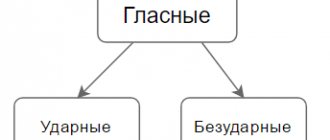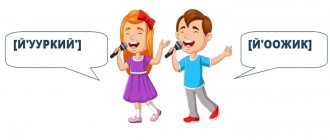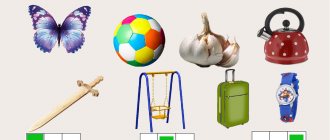I. Organizational moment.
The speech therapist invites students to remember and name the vowels of the first and second row.
II.
Repetition of previously covered material. The speech therapist invites students to remember how vowels of the second kind are formed. Posts a table with vowels of the first and second row.
| A | O | at | uh | s |
| I | e | Yu | e | And |
Offers comparison of pairs of vowels:
a - i, o - e, u - yu, z - e, y - i. The similarity of these pairs in articulation and the difference in spelling are revealed.
“These vowels are called paired vowels. In order not to confuse them when writing, we will learn to distinguish between them,” says the speech therapist.
Summary of a speech therapy lesson on the topic: “Differentiation of vowels O A”
Differentiation of sounds ( о ), ( а ) and letters
о , а in words.
(2nd grade) Tasks:
- Develop optical-spatial concepts and motor skills of the fingers.
- Improve the skills of syllabic analysis and synthesis, analysis of sentences by words.
- Develop sound-letter analysis skills.
- Enrich your vocabulary, develop coherent speech, the ability to compose a story (description of an object) according to a diagram, the ability to explain.
Material:
- game "Letter chains" (o →a
→
f
→
d
→
b); - game “Cobweb” (“Words”);
- syllabic text (for each child);
- game "Reader";
- a diagram for writing a story about vegetables and fruits;
- superimposed images of objects (“Vegetables and fruits”).
Lesson plan.
I. Organizational moment.
P. Development of optical-spatial concepts, ability to explain.
III. Speech therapy part of the lesson:
- Repetition of articulation of sounds [o], [a], writing letters o, a.
- Development of optical-spatial concepts, skills of syllabic analysis and synthesis.
- Development of skills in syllable analysis, analysis of sentences by words.
IV. Lexico-grammatical part of the lesson.
- Classification of names of vegetables and fruits.
- Writing a descriptive story about vegetables or fruits.
V. Development of motor skills of the fingers.
VI. Summary of the lesson.
Progress of the lesson
- Organizing time
II . Development of optical-spatial concepts, ability to explain
The speech therapist places a card on the board for the game “Letter Chains” (Fig. 5).
— In front of you is a card with letters written on it. Name them (o, a, f, d, b).
Explain how to make another letter from one letter.
What do I need to do? (you can remove or add any element)
This is followed by the children’s explanations (if there is difficulty, the speech therapist helps to give the correct answer).
III . Speech therapy part of the lesson
1. Repetition of articulation of sounds (o), (a), writing letters o, a
- What do the sounds [o], [a] have in common? (they are vowels, sung, belong to the 1st row of vowels)
- How are these sounds different? (when pronouncing the sound [o], the lips are rounded, and when pronouncing the sound [a], the mouth is wide open)
- What do the writing of letters have in common? (both letters contain the element “oval”)
- How are the spellings of letters different? oh, huh? (the letter “o” includes 1 element
-
“oval”, and the letter “a” has 2 elements
-
“oval” and “stick with a rounded bottom”), - Write a letter in the air o (children draw a letter in the air),
and now the letter a
.
2. Development of optical-spatial concepts, skills of syllabic analysis and synthesis
On the stand there is a card from the game “Spiderweb” (Fig. 6).
- Read the words by connecting the syllables in a web, focusing on the lines. Go out to the board one by one and write down the syllables in the correct sequence.
- What words did you come up with? (wasp, dog, cat, mountain, fence, rose, bark, album)
— Is the sound [o] always heard clearly in a word? (No)
Name the words in which the sound [o] is heard as [a]
(wasp, dog, mountain, bark).
— The spelling of the letter o must be checked by selecting a test word. But sometimes it is impossible to find a test word; the spelling of the word should be remembered.
- Write these words down. Highlight letters using encryption oh oh
-
underline
a “o”
into an oval.
3. Development of syllabic analysis, analysis of sentences into words
The speech therapist distributes cards with syllabic text.
Oh, how the artist did a great job. Painted the leaves on the trees. She worked hard in the fall and gave people a rich harvest.
— The next task is very difficult. There is text on the cards that lie in front of each of you. All words in it are divided into syllables. Try to determine which words are in each sentence in the text.
- Write the sentences in the form of diagrams. How many sentences are there in the text? (3)
- Insert letters oh oh
into words in a sentence pattern.
For example:
IV. Lexico-grammatical part of the lesson
1. Classification of the names of vegetables and fruits The speech therapist distributes cards with the game “Reader”.
TOMATO PUSTA ORANGE CARROTS GARLIC PERSUME LMEMON POTATO CUCUMBER BEET BLOCK PEAR LUXLIVAREPA EGGPLANT REDDISPPERZZUCCHOCANAPA
- The next task, “Reader,” is easier. Divide the notebook sheet in half. Read the words written on the cards. Write the names of fruits in the first column, the names of vegetables in the second column.
- Please note that the words in the “Reader” are written together, they need to be separated from each other.
For example:
tomato, cabbage, orange, carrot, garlic, persimmon, lemon, potato, cucumber, beetroot, apple, pear, onion, plum, turnip, eggplant, radish, pepper, zucchini, pineapple.
- Which suggested vegetables or fruits have no letters in their names? oh oh
?
(onion, radish, pepper) - Encrypt letters oh oh
(
o
into an oval, underline the letter
a
with one line)
2. Writing a story about vegetables or fruits
- And now we will try to write a story about a vegetable or fruit. Imagine that someone has never seen or tasted an apple. With the help of our story, maybe someone will want to try an apple. Each of you is offered a diagram with which you can write a story about a vegetable or fruit.
Outline of the story (description of the subject)
- ... is this a vegetable or a fruit?
- A vegetable grows in a vegetable garden in a garden bed (a fruit grows in a tree in a garden).
- Color.
- Form.
- Size,
- Taste.
- Smell.
For example.
Listen to my story about an apple (I follow the story outline).
- An apple is a fruit.
- It grows in the garden on a tree (apple tree).
- An apple can be green, red, yellow.
- The apple is round or oval.
- It is large in size, or it can be small.
- The apple has a sweet taste, but it can also be sweet and sour.
- The apple has a pleasant, aromatic smell.
- Who will try to write their own story? (children's answer options)
V. _ Development of motor skills of fingers
hands
The speech therapist distributes cards with images of superimposed contours of the objects “Vegetables and fruits” (Fig. 7).
- On the card there are images of vegetables and fruits; if desired, color either fruits or vegetables.
VI . Lesson summary
— What sounds and letters did we study in class? What do the sounds [o], [a] have in common? How are they different? What common element do the letters o, a
? How are their spellings different?
Autumn did a great job as an artist. She painted the leaves on the trees.
tomato, cabbage, orange, carrot, garlic, persimmon, lemon, potato, cucumber, beetroot, apple, pear, onion, plum, turnip, eggplant, radish, pepper, zucchini, pineapple.
__________________________________________________
Autumn did a great job as an artist. She painted the leaves on the trees.
tomato, cabbage, orange, carrot, garlic, persimmon, lemon, potato, cucumber, beetroot, apple, pear, onion, plum, turnip, eggplant, radish, pepper, zucchini, pineapple.
__________________________________________________
Autumn did a great job as an artist. She painted the leaves on the trees.
tomato, cabbage, orange, carrot, garlic, persimmon, lemon, potato, cucumber, beetroot, apple, pear, onion, plum, turnip, eggplant, radish, pepper, zucchini, pineapple.
__________________________________________________
Autumn did a great job as an artist. She painted the leaves on the trees.
tomato, cabbage, orange, carrot, garlic, persimmon, lemon, potato, cucumber, beetroot, apple, pear, onion, plum, turnip, eggplant, radish, pepper, zucchini, pineapple.
______________________________________________________
Autumn did a great job as an artist. She painted the leaves on the trees.
tomato, cabbage, orange, carrot, garlic, persimmon, lemon, potato, cucumber, beetroot, apple, pear, onion, plum, turnip, eggplant, radish, pepper, zucchini, pineapple.
IV. Differentiation s - and in syllables.
1. Listen to the syllables. Say what vowel you hear.
A
) Py. you, we, sy, ry, dy, would, ky;
b) pi, ti, mi, si. ri.di. bi, ki
“How are the consonants you heard first and then pronounced? (Hard, soft)
What sound here indicates the softness of the consonants? - asks the speech therapist.
2. Repeat the syllables after the speech therapist.
Py - pi - pi, ti - you - ti sy - sy - si ri - ry - ry dy - di - dy.
3. Write the syllables in two lines: s ы on the first line, s i on the second.
We, si, sy, mi, ry, ri, ti, you, ky, ki, li, pi, py, ly.
Task 4. Complete the words by inserting the syllables given in brackets.
Gri...(would), li...(py), le...(pi), bo...(would), ru...(ki),
ry...(would), la...(py), but...(gi), books...(gi), so...(you),
ke...(dy), be...(gi), ke
d...(ry),
ko ...(you), ka...(ti).
V. Summary of the lesson.
Presentation on the topic “Differentiation of vowels of the 1st and 2nd rows”
- April 25, 2011
Competition “Presentation Master”
Topic “Vowels of the 1st and 2nd rows. “Differentiation of hard and soft consonants when reading” is one of the important ones, because children with general underdevelopment have 3 levels: 1) reduced ability to analyze language phenomena; 2) insufficient development of auditory-verbal memory, attention, and self-control skills.
As a result, the main direction of work with children of level 3 OHP at stage I is the development of phonemic perception (phoneme differentiation) based on speech-auditory, speech-motor, and visual analyzers.
Main goal: distinguishing between replaced sounds. Each sound is associated with a specific letter. This activity is also a bridge to the next topic. Understanding and understanding the differentiation of hardness and softness of consonants will facilitate understanding of the use of the letter b in writing and speaking in Russian language lessons.
The purpose of the presentation : to update knowledge about vowels, develop phonemic perception, and instill a love for the Russian language.
The presentation material is presented from simple to complex (sound-letter, syllable, word, sentence).
Each slide solves a specific problem.
From 1 to 3 warehouses - an organizational stage that solves the problem of inclusion in the business rhythm; the technique used for this is fairy-tale characters and travel.
Slide 4 – application of blank techniques, task of classifying objects, positional analysis of letters in a word. Working on forms is most useful for students with impaired hand-eye coordination, fine motor skills, and lateralization problems, because the written load is dosed and oriented in space. Accurate inscription of symbols streamlines students’ orientation activities and self-control. When working systematically with the help of tasks on forms, the formation of concepts accelerates, and the connection between thinking and speech becomes stronger. In the future, the ability and habit of working with forms allows you to better navigate test tasks and more successfully cope with intellectual tasks in competitions, marathons, and exams in the form of the Unified State Exam. I use blank methods both for diagnostics and for classes as an effective way to correct writing disorders.
Slides 5 and 6 solve the problem of correctly checking the material covered, the optimal combination of control, self-control and mutual control for the correct completion of the task and correction of gaps.
Slide 7 – physical exercises. For physical exercises, I use video recordings that are interesting to children, repeated and subsequently spoken by the students together with the acting character.
The task of the warm-up is to develop fine motor skills before written work.
Slide 8 – task: consolidating acquired knowledge in a changed situation.
Slides 9 and 10 – creative work in groups. Task: analysis of new words, verification is carried out on the slide.
Independent work according to the speech therapy program “Delfa-142”. Each person completes the task individually, and the computer immediately gives the student the result.
Used to develop the skill of sound analysis when differentiating consonant sounds by hardness and softness.
The use of information technologies in domestic pedagogy is based on the basic psychological, pedagogical and methodological principles developed by L.S. Vygotsky, P.Ya Galperin, A.N. Leontyev, A.R. Luria, D.B. Elkonin and others.
Computer technologies are among the effective teaching tools that are increasingly used in special pedagogy.
Each new task of developmental education is transformed into problems of method, the development of workarounds for teaching, which would allow achieving the maximum possible success in the development of a child with special cognitive needs.
An analysis of the literature shows that computer tools represent for a specialist not part of the content of remedial education, but an additional set of possibilities for correcting deviations in the development of a child.
Appendix 1. Presentation.
Appendix 2. Development of a lesson on the topic “Vowels of the 1st and 2nd rows. Differentiation of hard and soft consonants in reading."
Author: Timirova Maryam Aitmukhametovna, teacher of Russian language and literature, teacher-speech therapist of the 1st qualification category, Municipal Educational Institution Secondary School No. 14, Nefteyugansk Khanty-Mansi Autonomous Okrug, Tyumen Region.


